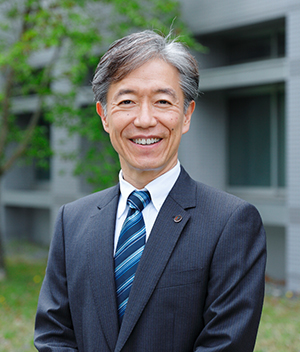
Kazuhiro SHIOZAKI
President
Transformative
The word "transformative" describes something that causes major change or brings significant progress or innovation. Nara Institute of Science and Technology (NAIST) was founded in 1991 as a postgraduate institution to transform scientific and technological research and human resource development in Japan.
In most universities, undergraduate programs are organized around the established academic frameworks, limiting the ability of the accompanying graduate programs to restructure or change. In contrast, having no undergraduate program, NAIST is characterized by its flexibility to reorganize educational and research programs in response to rapid advancements in science and technology.
In addition, the absence of undergraduate programs allows NAIST to admit students from a wide range of domestic and overseas universities, technical colleges, and working professionals. Such openness promotes student mobility and diversity. Graduate programs in many other Japanese universities mainly enroll students from their own undergraduate programs. On the other hand, NAIST has developed a student diversity comparable to that of graduate programs in the U.S. and Europe, where individuals from different backgrounds collaborate and learn from one another.
Our university has also been at the forefront of the internationalization of graduate education in Japan. We have created an inclusive academic environment by implementing biannual admissions in spring and fall, and offering courses, research training, and dissertation defense in both Japanese and English. Today, international students from more than 40 countries and regions make up one out of every four students at NAIST. Although located in Japan, NAIST provides a learning environment comparable to that of overseas graduate schools and develops globally minded professionals.
We are also proud of our transformative achievement in expanding the career paths of postgraduates. In Japan, it has been pointed out that graduate degrees, especially doctorates, are tied to academic careers, such as university faculty positions. In recent years, however, more than half of NAIST's doctoral graduates have chosen careers in industry or government. Our graduate education and career development programs have been successful in fostering not only academic researchers but also professionals who can contribute to society in various ways.
Never at a standstill, NAIST will continue to strive for yet another transformation. Our university has been selected for the Ministry of Education, Culture, Sports, Science and Technology's "Program for Forming Japan's Peak Research Universities," also known as "J-PEAKS". With this funding program, NAIST aims to establish a new model for sustaining and enhancing research and development in this country, where the working-age population is rapidly declining. In addition to cultivating highly skilled professionals, we will pursue the future of R&D, including open innovation based on research automation and advanced data utilization.
NAIST has continuously been reinventing itself while leading societal transformation. We remain committed to being a transformative university that continues evolving and inspiring change.



